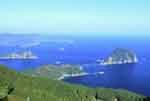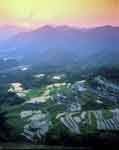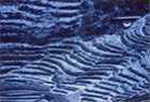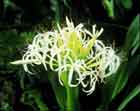 These two islands lie at the mouth of Owase Bay.
They are designated as special sanctuaries of the Yoshino
Kumano National Park and are highly valued for their
precious fauna and flora, and unique geological features.
Sabarujima Island, especially, has the biggest colony of
herons in Japan and is a major breeding ground for other
birds as well. The delicate ecology of ancient plants and
temperate climate evergreens is being carefully
preserved. Togashima Island has many unique species of
insects which can be found only on the Kii Peninsula. In
the photo you can see Togashima Island on the right and
the smaller one, Sabaru Island, on the left.
These two islands lie at the mouth of Owase Bay.
They are designated as special sanctuaries of the Yoshino
Kumano National Park and are highly valued for their
precious fauna and flora, and unique geological features.
Sabarujima Island, especially, has the biggest colony of
herons in Japan and is a major breeding ground for other
birds as well. The delicate ecology of ancient plants and
temperate climate evergreens is being carefully
preserved. Togashima Island has many unique species of
insects which can be found only on the Kii Peninsula. In
the photo you can see Togashima Island on the right and
the smaller one, Sabaru Island, on the left. to the top
 The 'Sea Turtle Park' is built as a park and
incubation center for turtles. We can feel and learn
about the mystery of the sea and can come to understand a
little about nature and the value of life by learning
something about the life cycles of the sea turtles. This
place is also designated as a 'Michi no eki', the
equivalent of a rest area on most North American
highways.
The 'Sea Turtle Park' is built as a park and
incubation center for turtles. We can feel and learn
about the mystery of the sea and can come to understand a
little about nature and the value of life by learning
something about the life cycles of the sea turtles. This
place is also designated as a 'Michi no eki', the
equivalent of a rest area on most North American
highways. to the top
 The Ida Coast in Kiho Town faces the Kumano Sea
and is known as an incubation ground for the Red Sea
turtles. Seasonally, Red Sea Turtles migrate from the
sea, crawl from the shore to the beach, dig the sand, lay
eggs, and pour sand over them to bury them. Local
elementary school students and adult nature lovers bring
these eggs to a special incubation compound in order to
save them from dogs or other predators. After about two
months the baby turtles are large enough to be able to go
back into the sea. At this time children again take them
back to the seashore and send them off to their home in
the Pacific.
The Ida Coast in Kiho Town faces the Kumano Sea
and is known as an incubation ground for the Red Sea
turtles. Seasonally, Red Sea Turtles migrate from the
sea, crawl from the shore to the beach, dig the sand, lay
eggs, and pour sand over them to bury them. Local
elementary school students and adult nature lovers bring
these eggs to a special incubation compound in order to
save them from dogs or other predators. After about two
months the baby turtles are large enough to be able to go
back into the sea. At this time children again take them
back to the seashore and send them off to their home in
the Pacific. to the top
 This is a photo taken near Tawara, Koza Town.
The mystic atmosphere captured in this photo can only be
seen on clear and cold days when the thick mist hangs
over the early morning sea. Kumano is rich in such
ephemeral miracles of nature which can be glimpsed only
under the rarest of conditions. This photo shows the
morning sun rising up out of the sea mist as viewed from
the coast of Tawara and can only be seen a few times a
year. This view conjures up the image, in the minds of
the locals, of hundreds of the Kumano Navy ships of
ancient times appearing out of the mists.
This is a photo taken near Tawara, Koza Town.
The mystic atmosphere captured in this photo can only be
seen on clear and cold days when the thick mist hangs
over the early morning sea. Kumano is rich in such
ephemeral miracles of nature which can be glimpsed only
under the rarest of conditions. This photo shows the
morning sun rising up out of the sea mist as viewed from
the coast of Tawara and can only be seen a few times a
year. This view conjures up the image, in the minds of
the locals, of hundreds of the Kumano Navy ships of
ancient times appearing out of the mists. to the top
 This is a photo taken in the district around
Kiwa Town. There are thousands of small terraced rice
paddies on the sides of steep mountains. There are more
than 2200 small rice paddies on these terraces.
This is a photo taken in the district around
Kiwa Town. There are thousands of small terraced rice
paddies on the sides of steep mountains. There are more
than 2200 small rice paddies on these terraces.  To
see thousands of terraced rice paddies lining the slopes
of steep mountains like this is quite a rare sight in
Japan. It is considered to be an unique and precious
remnant of the kind of landscape which would have been
found in a traditional mountain village, a scene that in
modern times can only be found in Kumano. In spite of a
modern trend to neglect such small terraced paddies in
favour of larger plots or tree plantations, Kiwa Town
insists on preserving this landscape and the people there
have instituted a local law called the 'Senmaida Act'.
Each terraced rice paddy is an average of 33 square
metres.
To
see thousands of terraced rice paddies lining the slopes
of steep mountains like this is quite a rare sight in
Japan. It is considered to be an unique and precious
remnant of the kind of landscape which would have been
found in a traditional mountain village, a scene that in
modern times can only be found in Kumano. In spite of a
modern trend to neglect such small terraced paddies in
favour of larger plots or tree plantations, Kiwa Town
insists on preserving this landscape and the people there
have instituted a local law called the 'Senmaida Act'.
Each terraced rice paddy is an average of 33 square
metres.
to the top
 This is one of the flowers which is
representative of the beautiful flora to be found in
Kumano. This flower is white with big green leaves, an
indication of it being from a warm southerly place. This
flower is the flower of Shingu City. You can see these
flowers growing in abundance on Kushima Island in
Miwasaki, an island which bustles with people enjoying
the beach and fishing in early summer.
This is one of the flowers which is
representative of the beautiful flora to be found in
Kumano. This flower is white with big green leaves, an
indication of it being from a warm southerly place. This
flower is the flower of Shingu City. You can see these
flowers growing in abundance on Kushima Island in
Miwasaki, an island which bustles with people enjoying
the beach and fishing in early summer. to the top
 The Fuketa Bog is found in Minachi, Hongu Town.
Here avid biologists will find a treasure house of
precious and unique aquatic insects and plants. This bog
became neglected when the population in this area began
to decrease. Recently some research was done by
elementary school children which found this place to be a
treasure house of insects and water plants. Hongu Town
began preserving and taking care of this bog and made it
into a nature park where people can observe the
interactions of nature without impacting on the ecology
there.
The Fuketa Bog is found in Minachi, Hongu Town.
Here avid biologists will find a treasure house of
precious and unique aquatic insects and plants. This bog
became neglected when the population in this area began
to decrease. Recently some research was done by
elementary school children which found this place to be a
treasure house of insects and water plants. Hongu Town
began preserving and taking care of this bog and made it
into a nature park where people can observe the
interactions of nature without impacting on the ecology
there. to the top
 From Mt. Yagi one can enjoy this view of Owase
City and the Magose Toge Pass. Travelling on the Kumano
Kodo Iseji Road, you can see the hamlet of Kuki quietly
nestled in a bay on the Pacific Ocean. You can also take
in the view of Hidegatake, the highest peak of
Odaigahara.
From Mt. Yagi one can enjoy this view of Owase
City and the Magose Toge Pass. Travelling on the Kumano
Kodo Iseji Road, you can see the hamlet of Kuki quietly
nestled in a bay on the Pacific Ocean. You can also take
in the view of Hidegatake, the highest peak of
Odaigahara. to the top